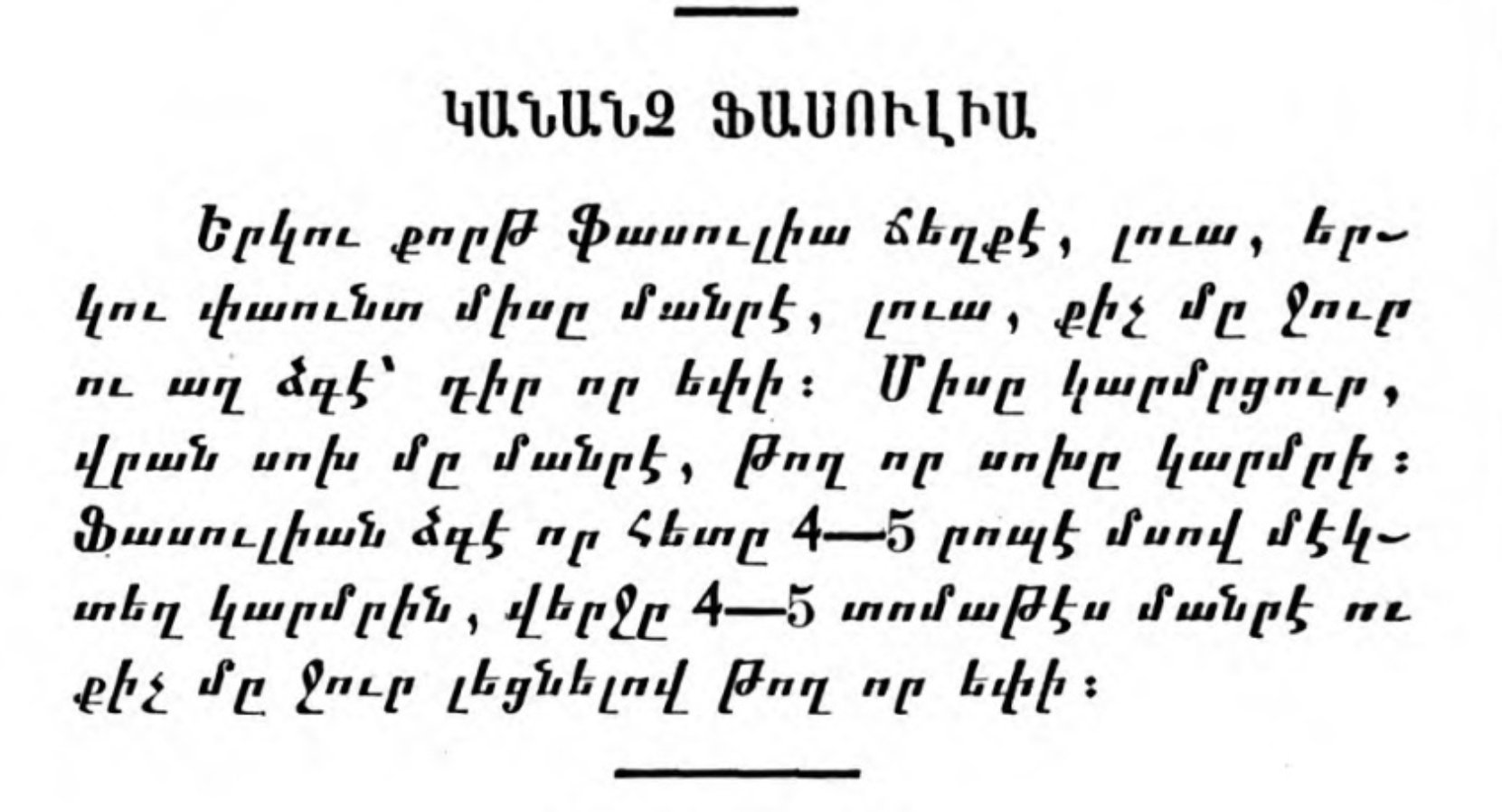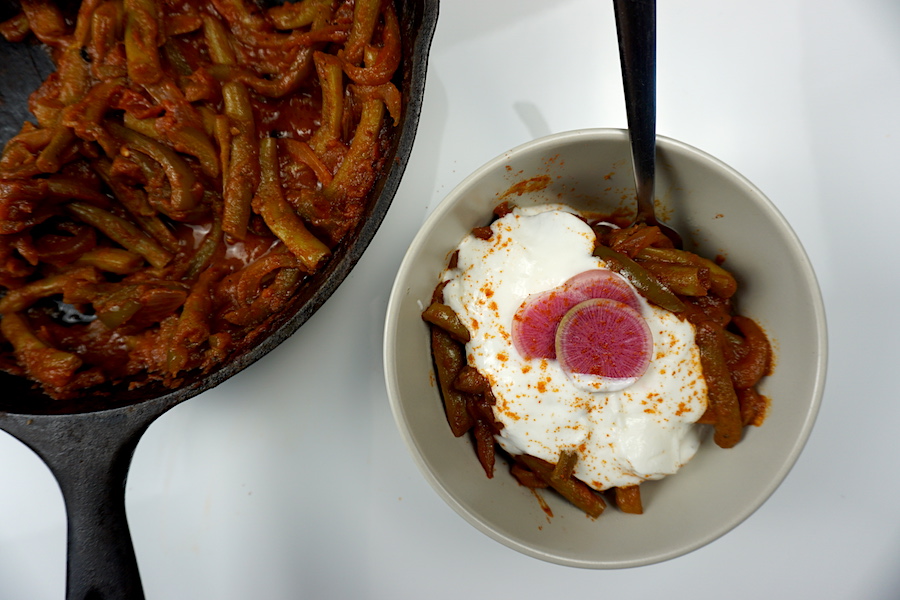Gananch Fassoulia or Green Beans
No matter what cultural cuisine they appear in, green beans are always a staple comfort food.
This is true for Armenians, too.
Their accessibility as vegetables - both in gardens and grocery stores in fresh and canned form, is perhaps what made them a commonly used ingredient in the dishes of ordinary people from many places in the world. Originating in Central and South America, the green bean was introduced to Europe and the Middle East over 500 years ago, becoming a major part of Armenian, Greek and Turkish cuisine. It's called "fassoulia" in many languages, because the genus name for beans is "Phaseolus."
Green beans or "gananch fassoulia" evoke strong feelings of nostalgia, identity and family life for Armenians in the same way they do for Americans from the South, particularly African-American communities who largely pioneered the cooking traditions that emerged out of the region. When people come from histories that include trauma, violence and pain, food is more than just food. Food becomes a vessel that holds memories, tells people who they are, gives them relief and is often a reason to celebrate the very fact that they even exist.
For Armenians, cooking, baking and eating food is an act of culinary resistance. Food is how the dead talk to the living. Gananch Fassoulia, whether it's made in Los Angeles, Beirut, Addis Ababa or London - is a perfect personification of that. Every family has their own recipe and version of this stewed meal that tastes especially good in the summer.
This recipe, however, comes from a special place: a 105-year-old cookbook published in America by an Armenian immigrant from Constantinople (Istanbul) in 1913.
The Oriental Cookbook," is one of the earliest examples of ethnic cooking published in America - perhaps the first one that encompasses "Oriental" cooking, which was a broader term back then that applied to everyone who was from Asia, including Armenians.
The book, the author mentions was a difficult task that was undertaken after realizing the demand among "Occidentals" or people from the "Western World" for "Oriental" cooking. It was written by A. Keoleian, a former newspaper editor back in the Ottoman Empire who dealt in rugs at some point in America, a common profession for Armenians in the West. It contained "wholesome, dainty and economical dishes of the orient, especially adapted to the American taste and methods of preparation."
The personal circumstances by which he came to America are unknown, but many of the Armenians who migrated to the U.S. before 1915 were fleeing the Hamidian Massacres, a preempt to the genocide which took place in the latter half of the 1890s.
"Often, the disposition of a person, or of a nation, can be traced back with considerable certitude to the kind of food which has been habitually eaten for long periods," he writes in the forward, where he explains the culinary habits of the people of the Orient, including Armenians, Turks, Persians, Syrians, Greeks and Jews.
He signs off with a fascinating farewell: "By the will of Allah, we remain, very sincerely yours."
What follows is over 300 pages of recipes, from meat to vegetable dishes, to pilafs, jams and desserts. It is incredibly thorough and originally sold for 25¢. The day this out-of-print book arrived after weeks of relentless searching, I read it from beginning to end like a novel. From the cover, to the recipes, to the publish date, it was unlike anything I'd seen before. I couldn't believe that an Armenian immigrant was not only responsible for this detailed compilation of the food of the Near East, but how, perhaps unbeknownst to him, he had put together a guide showcasing the history of the Armenian culinary tradition just two years before the genocide scattered survivors across the world and he had done it in America.
This gave me an over 100-year-old published document I could trace recipes back to. Several important Armenian cookbooks were printed in America in the 1940s and 50s, but anything before that was more or less oral tradition or not available in published form for the public. "The Oriental Cookbook" added an exciting element of depth to the Armenian culinary legacy in America (and the proliferation of Eastern cuisine).
A recipe for gananch fassoulia written in 1922 in an Armenian and English cookbook published in Fresno, California
Naturally, it was time to make a recipe from it. Armed with a several bundles of green beans I grew myself in the garden I've managed to miraculously keep alive, mostly thanks to the rich Michigan soil, I thumbed through in search of the "gananch fassoulia"/green bean recipe.
And sure enough, it was there all along, just like us.
Gananch Fassoulia/Tazeh Fassoulia Yaghli/Fresh Green Beans With Olive Oil
From The Oriental Cookbook, Published 1913
Ingredients:
4 cups green beans
3 medium dry onions
1 medium green pepper
2 ripe tomatoes (or 3-4 tablespoons canned tomatoes)
3 tablespoons olive oil
Salt and pepper to taste
Method:
Clean and trim the beans, cutting them in half lengthwise, crush with some salt and, after washing, arrange them in a suitable vessel. Slice over this the onions and green pepper. Also add the juice of the tomatoes. Season to taste, and after pouring in the olive oil, boil on a moderate fire for 10 to 15 minutes, when one half-cup of plain water should be added, and then left over a slow fire to simmer until done. Serve it hot or cold.
Note: though the recipe above is the original with nothing changed to preserve its historical accuracy, here are some additional tips:
• Heat the olive oil first and add the onion until they've softened (you can also choose to add 2-4 garlic cloves to add to the flavor)
• For even more flavor, you can use vegetable stock instead of plain water.
• The beans are cooked until they're very tender. Cover the pan or pot when simmering, and let them cook without disturbing them often for an hour or two (depending). You can also add more water as you see fit.
• For a bit of variety, you can add
• Serve with rice or bulgur pilaf, but don’t forget a nice big dollop of yogurt on top.




